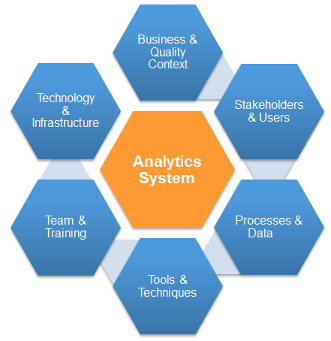 Healthcare analytics and IT are progressing rapidly
Healthcare analytics and IT are progressing rapidly
Healthcare analytics is a rapidly advancing field. Healthcare organizations (HCOs) along with the analysts, data scientists, and Information Technology (IT) professionals who work in them are faced with myriad choices regarding how best to meet the information and decision-making needs of administrators and, most importantly, clinical staff working on the front lines of healthcare. It seems as though there is a constant barrage of vendors offering new cloud solutions, data quality/management solutions, new business intelligence and analytics tools, and new data warehousing options, to name a few.
Because Healthcare IT and analytics are advancing so quickly, it is easy to spend an inordinate amount of time sifting through continuous offerings of the “newest, latest, and greatest” tool or technology searching for something that might be relevant to the needs of your HCO. Analyzing data, deploying systems, and building models without clearly knowing the information needs of the HCO, however, leads to wasted efforts, lost opportunities, and worse, may put patients at risk.
A case in point involves a very telling conversation in which a senior healthcare executive said to me, “we have all these dashboards, so why aren’t we seeing much improvement?” Looking back, it was probably because they had lost their focus on understanding what performance and quality-related information and insight the HCO really needed to transform the way in which healthcare was being delivered.
Understanding the information needs of a Healthcare Organization
In order to know what tools, technologies, and techniques are relevant, however, the current and future information needs of decision-makers within and HCO must be well understood; only then will it be possible to formulate an informed decision about which tools, techniques, and technologies to pursue.
To help better understand the information needs of an HCO, I’ve been working on and lecturing about a six-point Analytics System Framework that helps ensure that analytics capabilities within an HCO are in alignment with enterprise quality and performance goals and helps avoids the “all dashboard, no improvement” syndrome. The main points of the Analytics System Framework are illustrated in Figure 1 below:
Figure 1. Analytics System Framework
Details of the Analytics System Framework
As mentioned before, healthcare analytics is currently a very “trendy” topic. The internet is scattered with many buzzwords, marketing angles, white papers, and opinions on the topic of healthcare analytics. With all this “noise”, it is easy to get distracted from what is actually required, from an analytics perspective, by your organization. This Analytics System Framework helps cut through the noise and helps keep focus on what is important for the organization.
Rather than being seen as simply a collection of tools, reports, and exotic algorithms, it is important to view analytics as a system. I like to define analytics as “the system of tools, techniques, and people required to consistently and reliably generate accurate, validated, and trustworthy business and clinical insight.” This viewpoint elevates the conversation of analytics to the level of becoming a strategic information resource for healthcare organizations.
The six main components of the Analytics System Framework consist of:
- Business and quality context. Understanding the overall business and quality performance objectives of the organization is essential to developing an analytics system that can inform decision-making and help drive actions that can improve quality and performance.
- Stakeholders and users. A stakeholder is a person (or group of persons) that are impacted by, users of, or otherwise have a concern (or interest in) the development and deployment of analytical solutions throughout the healthcare organization. When developing the analytics framework, it is important to understand who the likely analytics stakeholders are, what each of the stakeholders will require, and develop approaches to ensure they are getting the information and insight they require to perform their job more effectively.
- Processes and data. Data is the raw material of analytics, and data and processes are very closely linked. It is the business processes and clinical workflows that generate data, and these same processes and workflows must be well understood to provide critical context to data for analysis. An analytics framework must address: how to determine which data is most necessary for quality, performance, and business improvement, how the data is managed and its quality assured, and how data links back to business processes to provide necessary context.
- Tools and techniques. Analytical tools must meet the requirements of analysts building analytics solutions/applications, and the end-users who will rely on the resultant information and insight. It is important to align analytics tools, methods, and capabilities with: business and quality questions that need to answered; relevant quality goals and Key Performance Indicators (KPIs); data available, stakeholder requirements and analytical sophistication, and appropriate statistical analyses. It is important to know if the analytics teams in the organization have all the necessary tools to accomplish the jobs they are tasked with, and what additional tools are required that would be more appropriate or more efficient for the types of analytics required.
- Team and training. PEOPLE are, by far, the most important consideration when developing an analytics infrastructure. An analytics framework must consider: what kinds of people (and the skills they bring) are necessary, how to attract the best analytical talent, and how to retain the analytic talent within your HCO.
- Technology and infrastructure. How well are current infrastructure (networks, servers, and storage) coping with analytic demand, and what performance issues or other gaps that may be limiting analytic capability and usefulness. Identify what gaps exist in the current technology and infrastructure that may constrain analytics within the organization.
Developing and implementing the Analytics System Framework
Of course, the information needs of HCOs are rapidly changing, but following the analytics system framework will help keep a finger on the “pulse” of the most pressing requirements of the HCO, and identify gaps in analytics capability that need to be addressed. Keep in mind that the framework is not akin to a simple “checklist” that can be completed once and never revisited. To continue gaining maximum leverage from your data and information systems, ensure that the framework is a living document, continually updated, that serves as a roadmap for guiding action and doesn’t become “shelfware” (that is, becomes obsolete and easier to ignore than update).
For more information: The Analytics System Framework is outlined in my book Healthcare Analytics for Quality and Performance Improvement; you can also learn more about the Analytics System Framework (which includes a detailed SlideShare deck and downloadable templates) on the “Analytics Primer” section of my blog: http://HealthcareAnalytics.info/analyticsprimer


{ 0 comments… add one now }